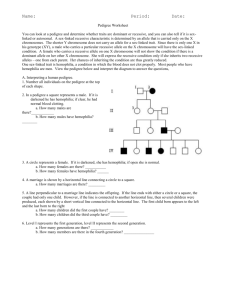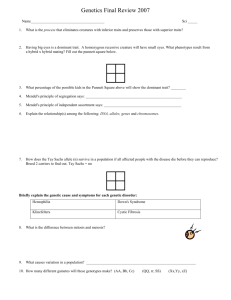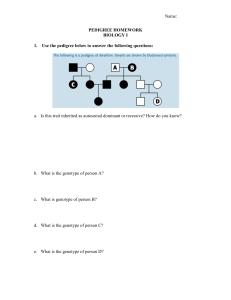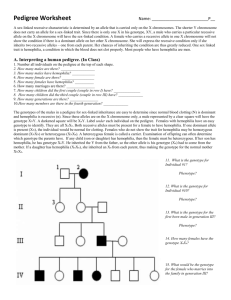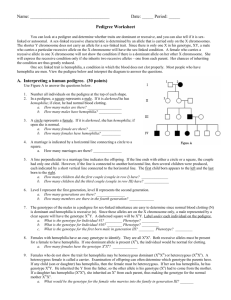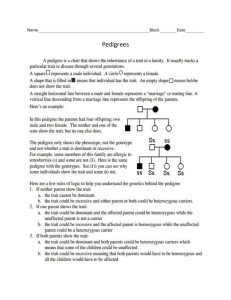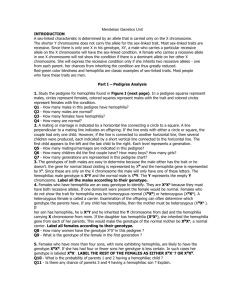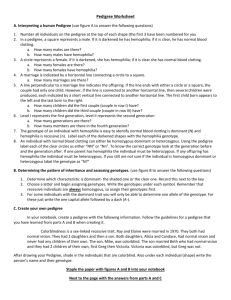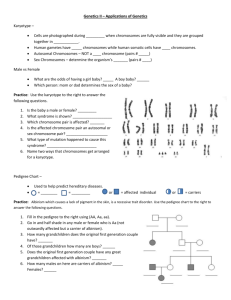Pedigree Worksheet
advertisement
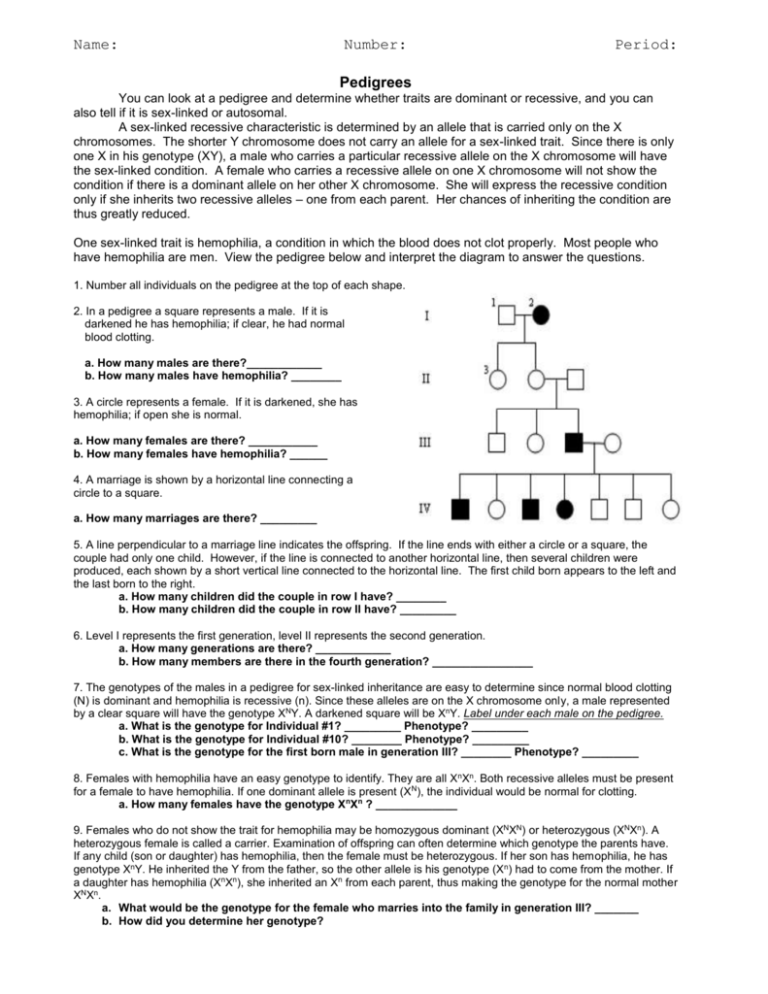
Name: Number: Period: Pedigrees You can look at a pedigree and determine whether traits are dominant or recessive, and you can also tell if it is sex-linked or autosomal. A sex-linked recessive characteristic is determined by an allele that is carried only on the X chromosomes. The shorter Y chromosome does not carry an allele for a sex-linked trait. Since there is only one X in his genotype (XY), a male who carries a particular recessive allele on the X chromosome will have the sex-linked condition. A female who carries a recessive allele on one X chromosome will not show the condition if there is a dominant allele on her other X chromosome. She will express the recessive condition only if she inherits two recessive alleles – one from each parent. Her chances of inheriting the condition are thus greatly reduced. One sex-linked trait is hemophilia, a condition in which the blood does not clot properly. Most people who have hemophilia are men. View the pedigree below and interpret the diagram to answer the questions. 1. Number all individuals on the pedigree at the top of each shape. 2. In a pedigree a square represents a male. If it is darkened he has hemophilia; if clear, he had normal blood clotting. a. How many males are there?____________ b. How many males have hemophilia? ________ 3. A circle represents a female. If it is darkened, she has hemophilia; if open she is normal. a. How many females are there? ___________ b. How many females have hemophilia? ______ 4. A marriage is shown by a horizontal line connecting a circle to a square. a. How many marriages are there? _________ 5. A line perpendicular to a marriage line indicates the offspring. If the line ends with either a circle or a square, the couple had only one child. However, if the line is connected to another horizontal line, then several children were produced, each shown by a short vertical line connected to the horizontal line. The first child born appears to the left and the last born to the right. a. How many children did the couple in row I have? ________ b. How many children did the couple in row II have? _________ 6. Level I represents the first generation, level II represents the second generation. a. How many generations are there? ____________ b. How many members are there in the fourth generation? ________________ 7. The genotypes of the males in a pedigree for sex-linked inheritance are easy to determine since normal blood clotting (N) is dominant and hemophilia is recessive (n). Since these alleles are on the X chromosome only, a male represented by a clear square will have the genotype XNY. A darkened square will be XnY. Label under each male on the pedigree. a. What is the genotype for Individual #1? _________ Phenotype? _________ b. What is the genotype for Individual #10? ________ Phenotype? _________ c. What is the genotype for the first born male in generation III? ________ Phenotype? _________ 8. Females with hemophilia have an easy genotype to identify. They are all X nXn. Both recessive alleles must be present for a female to have hemophilia. If one dominant allele is present (XN), the individual would be normal for clotting. a. How many females have the genotype XnXn ? _____________ 9. Females who do not show the trait for hemophilia may be homozygous dominant (XNXN) or heterozygous (XNXn). A heterozygous female is called a carrier. Examination of offspring can often determine which genotype the parents have. If any child (son or daughter) has hemophilia, then the female must be heterozygous. If her son has hemophilia, he has genotype XnY. He inherited the Y from the father, so the other allele is his genotype (Xn) had to come from the mother. If a daughter has hemophilia (XnXn), she inherited an Xn from each parent, thus making the genotype for the normal mother XNXn. a. What would be the genotype for the female who marries into the family in generation III? _______ b. How did you determine her genotype? Pedigree Practice (On your own) In humans, albinism is a recessive trait. The disorder causes a lack of pigment in the skin and hair, making an albino appear very pale with white hair and pale blue eyes. This disorder also occurs in animals, a common albino found in a laboratory is the white rat. The pedigrees below trace the inheritance of the allele that causes albinism. 1. Given the following genotypes, describe the phenotypes (normal or albino) AA = _____________________, Aa = ________________________, aa = __________________ 2. Fill out the blanks on the pedigree below 3. How many children does this family have? _______ How many are boys? ________ How many are girls? ________ 4. Fill out the blanks of the pedigree below (AA, Aa, or aa) 5. How many children does the original couple have? ______ How many are boys? ________ How many are girls? ________ 6. How many grandchildren does the original couple have? ______ How many are boys? ________ How many are girls? ________ 7. Rats can produce a lot more offspring than humans, making a pedigree more difficult to manage. A researcher has four female white rats named April, May, June, and July. One night, the cage was left open in the lab and a brown rat got into the female's cage. Six weeks later, the rats had litters of babies of varying colors. Two of the offspring managed to reproduce before the researcher was able to sort out the mess. Determine genotypes of the rats in this pedigree. Manny __________________ May ___________________ April ___________________ May ____________________ June ____________________ July ____________________
